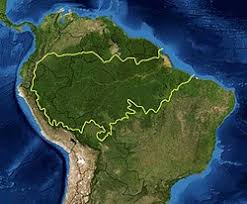|
|
|

MASS DESTRUCTION OF THE AMAZONIAN RAINFOREST  | Simo Jelača | |
| |
detail from: KRK Art dizajn
MASS DESTRUCTION OF THE AMAZONIAN RAINFOREST
SIMO JELAČA, Ph.D.
The Amazon River is the largest river in the world in terms of water volume, and it is the second longest river, after the Nile. It is located in South America and flows through Guyana, Ecuador, Venezuela, Bolivia, Brazil, Colombia and Peru. It is 6400 km long, with an average width of 48 km, and during rainy periods it reaches a width of up to 190 km. Its depths range between 20 and 100 m. The Amazon River flows into the Atlantic Ocean, bringing 200,000 liters of fresh water into the ocean every second, which is 25% of the total river fresh water that enters the oceans. The Amazon River is the most biologically diverse river on planet Earth.In the region of Amazonia, there are huge expanses of forests, about 7 million km2, of which 5.5 million km2 are rainforests, located in eight countries, from the Atlantic to the Andes.The Amazon Basin is one of the world's largest sources of human survival. About 300 species of fish, 427 species of mammals live in the Amazon River, and about 1,300 species of birds and 378 species of reptiles live in the region, and about 40,000 plant species grow.The forested areas of Amazonia belong to 60% Brazil, 13% Peru, 10% Colombia, and smaller parts belong to Ecuador, French Guiana, Suriname and Venezuela. The Amazon rainforests are the largest areas in the world. About 390 trillion trees grow in the Amazon region, classified into 16,000 tree species.The Amazon region is home to over 30 million people, 350 different groups of people, classified into nine nations and 3,344 indigenous groups. The Amazon is also a habitat for about 2.5 million insects. Biodiversity here is the greatest in the world. Most of the living conditions in the Amazon region are related to wood. The waters of the Amazon River are not clean enough to drink and must be purified.During the last sixty years, starting in 1960, massive deforestation occurred in the Amazon region. Local farmers mostly burned down the forests, turning the land into pastures for raising livestock, mostly cattle and, for growing soybeans. In this way, they destroy the entire biosystem of the environment. By 2022, 20% of the Amazon rainforest has been destroyed. The newly created arable land areas are fertile, because they were partially under water for centuries and were not polluted by chemicals. Since 1970, the construction of the Trans Amazon Highway began, and this is also an additional threat to the destruction of forests. It is evident that 415,000-587,000 km2 of forest were destroyed from 1991 to 2000, which were turned into pastures, and from 2000 to 2005 another 22,392 km2 of forest was destroyed.The main ways of destroying forests are forest fires, and in 2019 alone, 72,843 fires were caused. Deforestation changes the climate, creates an additional amount of carbon dioxide (CO2), which goes into the atmosphere and additionally pollutes it.That year alone, 110,000,000,000 tons of unnecessary carbon dioxide was created, and the production of oxygen (O2), which is produced by plants in the process of photosynthesis, was proportionally reduced. Unfortunately for mankind, this process is currently unstoppable and is even increasing continuously. Territories where Indigenous peoples live are increasingly endangered. In parts of Peru, rainforests are disappearing completely. In the period from 2002 to 2006, the destruction of Peru's rainforests even tripled, reaching over 1 million km2.The Amazon region produced 20% of the world's necessary oxygen (O2), necessary for the life of all living things, and with the burning of the rainforest, its production decreases, and the creation of carbon dioxide (CO2) increases, which further affects all climate changes, increasing the Earth's temperature, increasing the number of natural forest fires, increasing the number of river floods and the like, which was especially identified in 2023 in Canada. It is evident that the oxygen content in the atmosphere has decreased from 1990 until now by 0.005% and is no longer 20.95%, as it was since the beginning of the world. And in the regions of the Amazon, more carbon dioxide is emitted than the entire biosphere can absorb. It is evident that the number of forest fires in the Amazon region has increased sharply since the 1960s. It is known that about 40,000 forest fires burn almost continuously in that part of the world a year, and about 77% of forest areas are at risk, only in the Amazon region. And it is believed that other world rainforests have not been spared from similar destruction.Politicians of many countries are committed to reducing the destruction of nature, and a prominent example is Brazilian President Lula, who has proven to be a great fighter for the preservation of the natural resources of his country and world heritage. It is natural that Brazil fights for the preservation of tropical forests in its country, because only in Brazil they are 60% of the total world's rainforests. There are cases where some fires are caused by lightning, but most of them are started by peasants when burning dry residues from agricultural production and intentionally burning forests to gain pasture land. Natural regeneration of forests after fires is quite slow. Recent data show that in 2022, 7.5 million hectares of rainforest were burned in Brazil alone. Brazil, Colombia, Peru and Bolivia still hope to stop the burning of rainforests and are even planning their restoration. During 2023, they hired an additional 25,000 workers to prevent fires and protect forests.The most massive indigenous peoples living in the Amazon region are the Yanomamo and Kayapo tribes. They have lived there for thousands of years, and for hundreds of years they have had no contact with other civilizations. Besides them, there are 18 other groups of people who mainly live as guerillas, and that is why civilized people often call them "Uncontacted Indians". It is estimated that around 1.5 million indigenous peoples live in the Amazon regions, classified as in about 350 ethnic groups. In the other eight states, which belong to Amazonia, a total of 34 million indigenous peoples live, and about 100 tribes are completely isolated from the rest of the world.In the basin of the Amazon River is also its tributary, the Urubamba River, a Peruvian river, in the Quechua language it means magic, which has a length of 724 km, and partly flows past the famous Inca site of Machu Picchu. There it flows partly through the rainforest and in its course around Maću Piću it flows over rocks and is very noisy. Before reaching Machu Picchu, the Urubamba River flows past the small Inca town of Pisac, where it irrigates the flat fields extended below the terraced gardens where the local Inca population grows their grains and vegetables.The author stayed in Peru for three months, as a UN expert, in aid of the Yugoslav government to Peru, and visited the city of Cusco and the Inca fortress Machu Picchu, climbing to the very top of Huayna Picchu. Before returning, he cooled his face in the water of the Urubamba River. Since Machu Picchu is located in the rainforest, before the return train to Cusco, we went a bit into the rainforest to feel its charms.
 
Area Rainforest in South America Amazon Rainforest
|

















